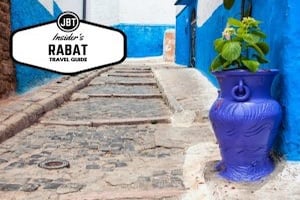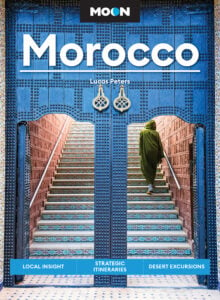 On a lonely stretch of desert road in southeastern Morocco, between Tazzarine and Rissani on the N12 highway, lies the small (pop. 3,170) town of Alnif. And while this oasis nestled on the southeast edge of the Anti Atlas Mountains is starkly picturesque, one would likely keep driving through were it not for one thing: For fossil hunters, this is paradise. Alnif and the surrounding basin is the best place in Morocco, and one of the most renowned in the world, for collecting the prehistoric creatures known as trilobites.
On a lonely stretch of desert road in southeastern Morocco, between Tazzarine and Rissani on the N12 highway, lies the small (pop. 3,170) town of Alnif. And while this oasis nestled on the southeast edge of the Anti Atlas Mountains is starkly picturesque, one would likely keep driving through were it not for one thing: For fossil hunters, this is paradise. Alnif and the surrounding basin is the best place in Morocco, and one of the most renowned in the world, for collecting the prehistoric creatures known as trilobites.
Once, for 300 million years, the sea-dwelling creature akin to a crab was the most successful species on the planet. Trilobites can be found on every continent, and fossils range in size from a few centimeters to up to 90 cm long. In this arid and sparsely populated corner of Morocco, enthusiasts will be able to wander the landscape looking for signs that, unbelievably, this was once a vast sea, and the proof is literally at your feet. One of the earliest trilobites (Hupetina antiqua) was discovered here, and excursions to find the spiny invertebrates are one of the most popular activities in the region. However, given the difficulty of the terrain, it is best to hire a knowledgeable guide to escort you on your hunt. If you are new to the world of ancient aquatics, the Ihmadi Trilobites Centre is a good place to educate yourself before trekking across the hamada and also to purchase genuine fossils if you are short on time or inclination to find your own. Fossils—including child-friendly souvenirs like dinosaur teeth—are readily available at roadside stands and other venders, but beware: Fakes of stone, ceramic or plastic, or cobbled-together fragments, are rampant.
The traces of antiquity in the Alnif basin are not limited to animals. Other sites in the nearby Draa Valley include rock engravings and rock paintings from all main periods of the human prehistory of the Sahara. There is some evidence that human activity in the region dates back nearly 300,000 years. Foum Chenna (Tinzouline), Aït Ouaazik (Asguine Tarna, Tazzarine) Tiouririne e Tisguinine (Zagora) are all worth a stop.
If having the short history of the world at your fingertips hasn’t made you yet contemplate the mysteries of the universe, then a night under the Sahara stars might just put it all in perspective. Either by camel or 4×4, excursions into the dunes of the world’s largest desert are a magical experience. Imagine a traditional Berber tent with rich amenities and entertainment, or a simple sleeping bag with the sound of the wind whistling over the sands. Treks range from overnight to weeks long, with luxuries limited only by the depth of your imagination and wallet.
Written by Erin Tolman.
Photo by Wyoming_Jackrabbit.








